Meet Carnoustie’s links superintendent: Craig Boath
Related Articles
Craig talks about managing three 18-hole courses during a pandemic, a major cabling project to connect to a wind farm, partnering with other links courses and the products he uses to achieve optimal maintenance.
Carnoustie Golf Links in Angus is, of course, one of the greatest golfing venues in the world. It has four courses, the historic Championship Course, the Burnside Course, the Buddon Links Course and a free-to-play short, five-hole course, The Nestie. It has hosted the Open Championship eight times, the most recent in 2018, as well as several other prestigious events in just the last decade such as the Senior Open Championship and the Women’s British Open.
In 2019 Craig Boath was promoted from head greenkeeper of the Championship Course to the new links superintendent at the venue.
We talk to him about his career, especially the last two years, and the challenges involved in maintaining these golf courses.
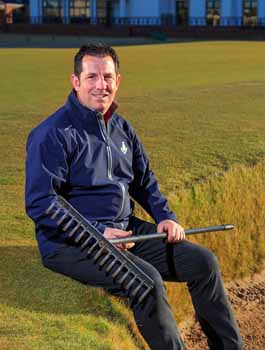
Hello Craig, can you give a brief description of your background and your rise to become links superintendent at Carnoustie?
When I was younger, I wanted to become a farmer. My granny and grandad had a farm which was passed on to my uncle – unfortunately he died young and my mum told me there was no money in farming. One day, I was out playing golf with my dad and I noticed the greenkeepers building a bunker which I thought was interesting and of course they had a tractor which was even more appealing.
This seemed to be a great career to get involved in.
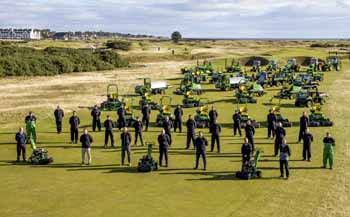
I first met John Philp MBE, in the February of 1995. I was looking to do some work experience through Monifieth High School, it took me several visits to persuade John to let me come along for the week. After that week, I came back to work in my Easter holidays and then again during my ‘Tattie’ (October) holidays. I then pleaded for John to let me join the greenkeeping team the following year to start full-time employment.
I started as a youth trainee for a two-year spell, then went on a two-year contract as an apprentice. John took me on as a full-time greenkeeper after one year of that. I worked on all three courses at Carnoustie (Championship, Burnside and Buddon), as well as going to Elmwood College, Cupar on block release greenkeeper training learning my NC.
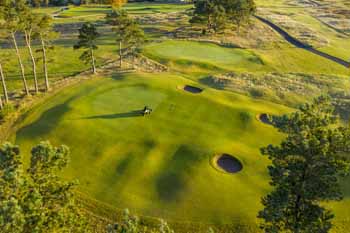
After working my way on all three courses I was then made a deputy head greenkeeper on the Burnside Course in 2005 and was then made deputy head greenkeeper on the Championship Course under Sandy Reid (now St Andrews’ director of Greenkeeping) prior to the 2007 Open Championship. In 2012 John Philp retired and Sandy took over as links superintendent, I then became head greenkeeper on the Championship Course. Sandy left to go to St Andrews in November 2018 after the Open, I then took over as links superintendent. As well as numerous college courses and other ways of educational learning, I was also selected to become part of the R&A Scholarship Programme in 2018. The scholarship has not only provided me with a network of newer friends in the greenkeeping world but also opportunities to extend my education and experiences. Of course, the ability to climb the greenkeeping ladder would not be possible without the support of my family. My wife Susan and girls Molly, Fern, Poppie and Sadie are very patient with me going in and out of work, especially when big tournaments come up and contractors need you at all hours of the day.
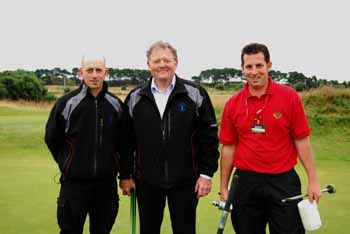
What is the size of your team and how do you maximise resources?
We have a team of 25, who are all well experienced and well trained in the various bits of kit required on the golf courses here at Carnoustie. The whole team know what is required to present three great golf courses. In the height of summer, we bring in three full-time seasonal greenkeepers to help with various tasks and another six part-time seasonals to help with divotting tees / fairways and so on. My life is made easier with the help of Kevin Stott, who is the Championship Course manager and Sandy McCubbin, who looks after all machinery maintenance side of things.
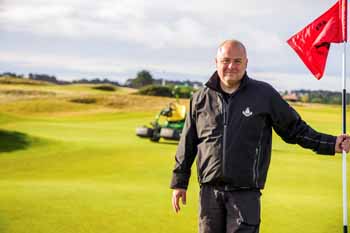
What would you say are the biggest challenges you currently face and how do these impact you in your current role?
The whole Covid-19 restrictions that every golf course has been facing, making sure that all staff are working in a safe environment, whilst trying to take advantage of the furlough scheme and at the same time make sure that all tasks on the course are covered. It has been a frustrating and an emotional time, not knowing what is around the corner and having to plan for different scenarios. It’s not just me that has had that problem and other golf courses up and down the country will be the same but it’s these issues that keep you awake at night.
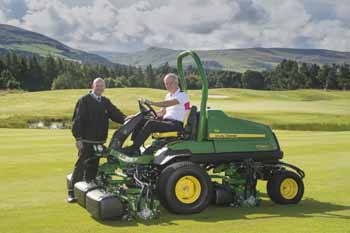
The onshore programme to lay the underground cable work from the Seagreen offshore wind farm is a current project you are working in partnership with. How have you collaborated to ensure minimum impact to the course and what have you personally learnt from this experience?
The wind farm project will see three lines of cables come though the Buddon Course and along four holes. We have been working closely with SSE, Nexans and Roadbridge to try and make as little disruption as possible. Like any other project, it started later than it should have and after a period of prolonged rain the route which they were ploughing through was saturated making a bit more damage to the turf than was first realised. At the time of writing, the team were back just after the Christmas holidays and have started to plough again. On the back of all the works complete we will have over 50,000 square metres to prepare and re-turf / seed, hopefully we can get on with this sooner rather than later. Hopefully no more delays in the project will hold us up. From a learning point of view – don’t work with contractors and sub-contractors!! Joking aside, it has been a good project to work on and something a little bit different. The wind farm is located 27km off the shore and the links is the first point of the land that 19km of underground cabling will start to be ploughed in. I have been working closely with Bob Taylor (formerly of STRI) and Sophie Olejnik (STRI), making sure that all areas are dealt with properly such as heather, tree felling, root clearance, water courses and so on. Bob has such knowledge and it’s good to spend some time learning from him.
You mentioned John Philp MBE. What were the things that you saw and learned from him that have helped you progress in your career?
John was not only a great boss to me but is always someone that I can talk to about things on the course or pick his brain on other historical issues that have come up in his career here. In the early days John could be very tough and hard but when you look back at all the progress we made on the course, it helped Carnoustie get the Open back in 1999 after a 24-year absence. The changes we made to the course were probably not appreciated by golfers back then, but it transformed Carnoustie into what is now a world class golfing venue. John set the high standard that was required back then for years to come and it is still ongoing to this day. My dad died six weeks before the Open in 1999 and John was very good to me in making sure that I was OK but at the same time gave me the gentle nudge to push me on. He was instrumental in making sure that I learned about other aspects of greenkeeping, thinking outside the box and encouraged me into further education.
Carnoustie has four Tru Turf greens irons. What determines when or how often the team uses the irons and how does this help the presentation and playability of the course?

A lot of golfers and some greenkeepers for that matter get hung up on the speed of the greens – ‘they need to be fast; they need to be like they are in America’ and so on. Good golfers like to putt on greens that are firm, smooth and true – a consistency between all 18 greens and the putting green. The Tru Turf greens rollers help out with all three characteristics that are required for the golfer, it is also a great tool to help miss out a cut if required.
You’ve said the further up the ladder you go, you can find yourself becoming more distant from the daily greenkeeping work. How do you ensure you don’t lose touch with your roots?
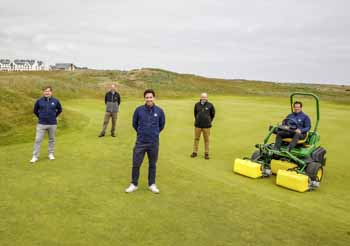
I seem to be stuck in the office a little bit more often now, but I do try to get out on the course to see what is happening. It’s good to get out and speak to the team and try to help if and when I can. Sometimes get my hands dirty!
How do you ensure top quality is maintained across the courses at all times and what benchmarks do you put in place to adhere to?
It’s back to the way we were brought up with John Philp; he set the benchmark for us and we have carried it on through the years and raised the bar furthermore. We want visitors to come here and play the course that the pros play and in the best conditions. It is a bucket list trip. As I said before, we always have one eye on our next tournament and the inputs that go in year on year, making sure that we are producing a top quality golf course.
You’ve recently invested in a John Deere fleet and are working with Double A. What was it that particularly attracted you towards John Deere, what do you see as the major benefits of the new partnership and looking forward, how do you see this partnership contributing to the team, the courses and to Carnoustie Links’ global reputation?
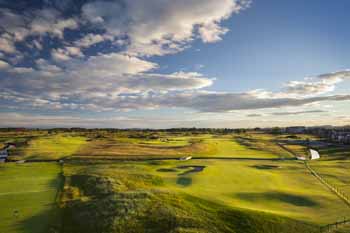
Carnoustie – Championship Course
We went through a tendering process with three companies, John Deere being one of them. We wanted a company to show us what they were about in terms of environmental sustainability, implementing the latest forms of techniques, technologies, and innovations as well as creation of a strategic partnership. In the future, we are also looking at ways to form an apprenticeship programme. The chance for young, up and coming greenkeepers to learn not just at Carnoustie Golf Links but other courses around the world with the help of John Deere. Introducing them to the machines, products and greenkeeping practices of tomorrow, today.
Double A has supplied your John Deere machinery fleet, what level of support have you received and what has impressed you most from the dealership, and in your position, what is it that you need from a dealership?
I have known Sandy Armit and most of his team at Double A for a long time now and they have always been very friendly, accommodating and helpful with making sure that we have the right machinery as well as the proper back-up. From late night emails to phone calls, the team at Double A have always promptly answered making sure that we have the right level of support. Sandy has a great team under him (aftersales manager Barry Cameron, sales manager Ross Kelly and golf sales specialist John Bateson) and we are looking forward to creating a long term partnership with them.
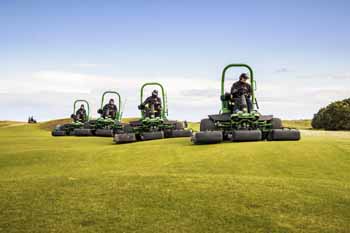
The advancement and use of technology for the course manager has leaped over the past 12 years. What are your views toward technology and how are you embracing it to drive the management of the courses and the business?
You cannot shy away from technology; you have to embrace it and use it to benefit you and the golf courses. GPS sprayers are a prime example where the most up to date technology can help you efficiently in terms of saving time and products whilst spraying precisely the area selected. We have started using other management tools to keep track on how machinery is performing and where on the course it is working. This comes in handy for our maintenance engineers for keeping an eye on service hours as well as service history.
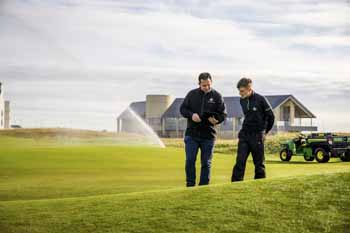
Carnoustie will see the return of The AIG Women’s Open in 2021. What preparation and programmes will you set in place in the lead up to the event and what benefit do you think the event will deliver to the Carnoustie Women in Golf Programme, the Girls Empowerment Academy and the 250 junior golf development participants?
It is a wonderful opportunity for all of our participants involved in our Women in Golf Programme and Girls Empowerment Academy as well as the 250 junior golf development programme participants (The Carnoustie Craws) to see the world’s best women players up-close. Carnoustie continues to lead in the modernisation of the game of golf and has the added benefit that our courses are always in a championship-ready condition. I am sure that watching the top women in the world will inspire even more people of all ages and abilities to get involved, have fun and explore the health and wellbeing benefits of golf, especially at Carnoustie Golf Links.
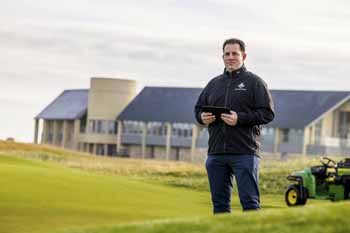
Many courses are struggling to recruit the new generation of greenkeepers. What are your views on this?
I think every course struggles to get someone young enough and keen enough to get involved in greenkeeping. I think we are often too late to the party and we should be going into primary schools, teaching them more about what happens on a golf course rather than at high school. We need to get youngsters interested from an early age. In the past we have had primary classes out planting trees or sowing wildflower seeds along with the chance to have a shot at golf. We need to be encouraging more as this is our future customers as well as our next generation of greenkeepers.
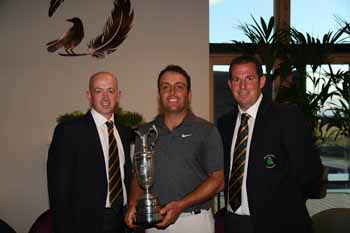
The level of winter course renovation across the courses at Carnoustie can be high, what projects are being undertaken for this period?
I think a lot of visitors, season ticket holders and even staff from other departments think that when the playing (summer) season finishes we just sit in the sheds waiting for something to do, but winter can also be a very busy period too. We always have one eye on our next major tournament and the course has to move forward in the terms of playability and from a maintenance point of view. Projects on all three courses can vary from bunker revetments, re-turfing tees to other jobs such as spectator mounding to drainage works. There are other routine tasks that also need doing through the winter such as verti-draining all areas, spiking, gorse clearance / coppicing and course set-up as the golf courses are open near enough 365 days of the year. This winter prior to the AIGWO, nearly 30 bunkers out of the 112 were rebuilt.

Carnoustie – Championship Course
Carnoustie Links will shortly embark on a full renovation of all courses and upgrade them with the most advanced irrigation technologies. What criteria did you set out to help you in your decision-making process?
As part of the machinery fleet deal, the irrigation was part of that too and through John Deere collaboration, Rain Bird were brought in to help on that side of things. We needed to go back to the start with our irrigation set-up, looking at locations of the pumphouse and looking at the whole layout to see if that matches what we require. We need to fine-tune the new system and work it to continually monitor conditions across the links and with that it will work with us to apply the precise amount of irrigation each area needs. The new system will provide us with up-to-date data to help inform course management decisions. My aim is to have the safest and most future-proof system out there and with Rain Bird I think we can achieve that.
What do you think are the qualities now needed to meet the requirements and demands of golfers by someone in your position and how does this help contribute to the business of golf?
It’s more a pressure on the team; we are responsible for making sure that golfers that come to play the great Links at Carnoustie have an unforgettable experience. We want golfers that have played here to watch tournaments on TV and remember the good times when they visited. You must be tough-skinned nowadays, golf is changing. In the past, once you get to November, the clubs would be put away in the garage until the following spring, but it is becoming more and more a 12-month sport. The pressure is now on all golf courses to provide a surface all year round and it will end up having a detrimental effect on some of the smaller courses that need the money to survive. You cannot constantly batter the course and not give it the rest it needs.
What currently gives you the greatest satisfaction from your job?
I am lucky to have a job that I love doing, I think that is satisfaction in itself. It is a team achievement at Carnoustie Golf Links, and it’s not just over the last few years it has been from gradual improvements on the courses over the last few decades. When moving around the courses you can see where improvements have been made and been beneficial to everyday golf as well as for tournaments and spectator movement. After a tournament, it is always a time to reflect and have that feeling of satisfaction before moving on and preparing for the next event.
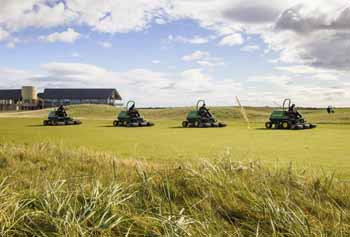
How would you describe your style of management and why do you prefer to work this way?
I think I am pretty fair to all staff and give them a chance to put ideas forward and to let them experiment and express themselves. I want people to enjoy coming to work. I feel you get more out of staff with that work ethic.
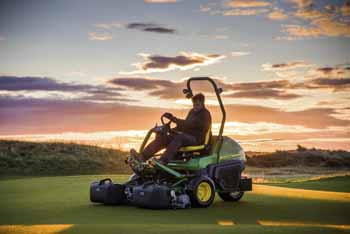
With your many years experience, what advice would you give to youngsters starting out and wanting to pursue a career in the profession?
It is a thankless task, and most of the time golfers don’t really know what we do as everything is done before they show up, but we do it because we love what we do.
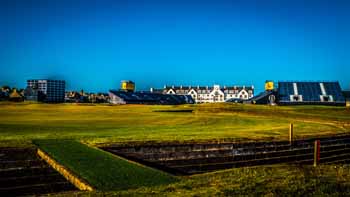
18th hole prior to The 147th Open
Working outdoors, working with the newest technology about, a chance to travel the world to work at other courses not just in the UK plus the ability to get close to the top golfers in the world and have a front row seat in major tournaments.
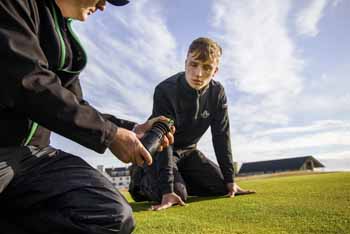
What changes do you think need to be made to benefit the industry sector and profession of the greenkeeper?
As an industry I think we need to become tighter, help each other out, share ideas more and just talk to each other. There is a lot more focus on mental health issues and by picking up the phone and talking to your neighbouring greenkeeper down the road might just help him / her see a chink of light in their problems. Together with Paul Larsen (Royal St Georges), Richard Wyman (Burnham and Berrow), Rhys Butler (Royal St Davids) and Ian Kinley (Royal Portrush), we have come up with a ‘Links Club’, a joining of links courses from around the UK to get together share ideas, learn new techniques and just to talk to each other. I think this is another event where we can all come together as one. We have seen the great success the ‘Irish Links Initiative’ has had and to replicate that with numbers they have achieved would be great.

























